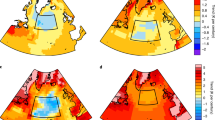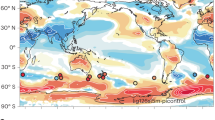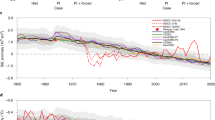Abstract
The possibility of a reduced Atlantic thermohaline circulation in response to increases in greenhouse-gas concentrations has been demonstrated in a number of simulations with general circulation models of the coupled ocean–atmosphere system. But it remains difficult to assess the likelihood of future changes in the thermohaline circulation, mainly owing to poorly constrained model parameterizations and uncertainties in the response of the climate system to greenhouse warming. Analyses of past abrupt climate changes help to solve these problems. Data and models both suggest that abrupt climate change during the last glaciation originated through changes in the Atlantic thermohaline circulation in response to small changes in the hydrological cycle. Atmospheric and oceanic responses to these changes were then transmitted globally through a number of feedbacks. The palaeoclimate data and the model results also indicate that the stability of the thermohaline circulation depends on the mean climate state.
This is a preview of subscription content, access via your institution
Access options
Subscribe to this journal
Receive 51 print issues and online access
$199.00 per year
only $3.90 per issue
Buy this article
- Purchase on Springer Link
- Instant access to full article PDF
Prices may be subject to local taxes which are calculated during checkout




Similar content being viewed by others
References
Ganachaud, A. & Wunsch, C. Improved estimates of global ocean circulation, heat transport and mixing from hydrographic data. Nature 408, 453–457 (2000).
Weaver, A. J., Bitz, C. M., Fanning, A. F. & Holland, M. M. Thermohaline circulation: High latitude phenomena and the difference between the Pacific and Atlantic. Annu. Rev. Earth Planet. Sci. 27, 231–285 (1999).
Killworth, P. D. Deep convection in the world ocean. Rev. Geophys. Space Phys. 21, 1–26 (1983).
Grumbine, R. W. A model of the formation of high-salinity shelf water on polar continental shelves. J. Geophys. Res. 96, 22049–22062 (1991).
Stommel, H. Thermohaline convection with two stable regimes of flow. Tellus 13, 224–230 (1961).
Bryan, F. High-latitude salinity effects and interhemispheric thermohaline circulations. Nature 323, 301–304 (1986).
Manabe, S. & Stouffer, R. J. Two stable equilibria of a coupled ocean-atmosphere model. J. Clim. 1, 841–866 (1988).
Weaver, A. J. in Natural Climate Variability on Decade-to-Century Time Scales (eds Martinson, D. G. et al.) 365–381 (National Research Council, National Academy Press, Washington DC, 1995).
Alley, R. B. & Clark, P. U. The glaciation of the northern hemisphere: a global perspective. Annu. Rev. Earth Planet. Sci. 27, 149–182 (1999).
Stocker, T. F. Past and future reorganization in the climate system. Quat. Sci. Rev. 19, 301–319 (2000).
Broecker, W. S. Thermohaline circulation, the Achilles heel of our climate system: Will man-made CO2 upset the current balance? Science 278, 1582–1588 (1997).
Alley, R. B. et al. Abrupt Climate Change: Inevitable Surprises (National Research Council, National Academy Press, Washington DC, in the press).
Cubasch, U. et al. in Climate Change 2001—The Scientific Basis: Contribution of Working Group I to the Third Assessment Report of the Intergovernmental Panel on Climate Change (eds Houghton, J. T. et al.) 525–582 (Cambridge Univ. Press, Cambridge, 2001).
Manabe, S. & Stouffer, R. J. Century-scale effects of increased atmospheric CO2 on the ocean-atmosphere system. Nature 364, 215–218 (1993).
Stocker, T. F. & Schmittner, A. Influence of CO2 emission rates on the stability of the thermohaline circulation. Nature 388, 862–865 (1997).
Schmittner, A., Yoshimori, M. & Weaver, A. J. Instability of glacial climate in an earth system model. Science (in the press).
Dickson, R. R. & Brown, J. The production of North Atlantic deep water: Sources, sinks and pathways. J. Geophys. Res. 99, 12319–12341 (1994).
McCartney, M. S. Recirculating components to the deep boundary current of the northern North Atlantic. Prog. Oceanogr. 29, 283–383 (1992).
Labeyrie, L. et al. Changes in vertical structure of the North Atlantic Ocean between glacial and modern times. Quat. Sci. Rev. 11, 401–413 (1992).
Vidal, L., Labeyrie, L. & van Weering, T. C. E. Benthic δ18O records in the North Atlantic over the last glacial period (60–10 kyr): Evidence for brine formation. Paleoceanography 13, 245–251 (1998).
Sarnthein, M. et al. Changes in east Atlantic deepwater circulation over the last 30,000 years: Eight time slice reconstructions. Paleoceanography 9, 209–267 (1994).
Yu, E. F., Francois, R. & Bacon, M. P. Similar rates of modern and last-glacial ocean thermohaline circulation inferred from radiochemical data. Nature 379, 689–694 (1996).
Rutberg, R. L., Hemming, S. R. & Goldstein, S. L. Reduced North Atlantic Deep Water flux to the glacial Southern Ocean inferred from neodymium isotope ratios. Nature 405, 935–938 (2000).
Frank, M. Comparison of cosmogenic radionuclide production and geomagnetic field intensity over the last 200,000 years. Phil. Trans. R. Soc. Lond. A 358, 1089–1107 (2000).
Finkel, R. C. & Nishiizumi, K. Beryllium 10 concentrations in the Greenland Ice Sheet Project 2 ice core from 3–40 ka. J. Geophys. Res. 102, 26699–26706 (1997).
Muscheler, R., Beer, J., Wagner, G. & Finkel, R. C. Changes in deep-water formation during the Younger Dryas event inferred from 10Be and 14C records. Nature 408, 567–570 (2000).
Marchal, O., Stocker, T. F. & Muscheler, R. Atmospheric radiocarbon during the Younger Dryas: production, ventilation, or both? Earth Planet Sci. Lett. 185, 383–395 (2001).
Broecker, W. S., Mix, A., Andree, M. & Oeschger, H. Radiocarbon measurements on coexisting benthic and planktic foraminifera shells: potential for reconstructing ocean ventilation times over the past 20000 years. Nucl. Instrum. Methods Phys. Res. B5, 331–339 (1984).
Sikes, E. L., Samson, C. R., Guilderson, T. P. & Howard, W. R. Old radiocarbon ages in the southwest Pacific Ocean during the last glacial period and deglaciation. Nature 405, 555–559 (2000).
Cuffey, K. M. et al. Large Arctic temperature change at the Wisconsin-Holocene glacial transition. Science 270, 455–458 (1995).
Bard, E., Rostek, F., Turon, J.-L. & Gendreau, S. Hydrological impact of Heinrich events in the subtropical northeast Atlantic. Science 289, 1321–1324 (1999).
Severinghaus, J. P. & Brook, E. J. Abrupt climate change at the end of the last glacial period inferred from trapped air in polar ice. Science 286, 930–934 (1999).
Hughen, K. A., Southon, J. R., Lehman, S. J. & Overpeck, J. T. Synchronous radiocarbon and climate shifts during the last deglaciation. Science 290, 1951–1954 (2000).
Stocker, T. F. & Wright, D. G. Rapid transitions of the ocean's deep circulation induced by changes in surface water fluxes. Nature 351, 729–732 (1991).
Manabe, S. & Stouffer, R. J. Coupled ocean-atmosphere model response to freshwater input: comparison to Younger Dryas event. Paleoceanography 12, 321–336 (1997).
Fanning, A. F. & Weaver, A. J. Temporal-geographical meltwater influences on the North Atlantic Conveyor: Implications for the Younger Dryas. Paleoceanography 12, 307–320 (1997).
Bond, G. C. et al. in Mechanisms of Global Climate Change at Millennial Timescales (eds Clark, P. U., Webb, R. S. & Keigwin, L. D.) 35–58 (Geophysical Monograph 112, American Geophysical Union, Washington DC, 1999).
Clark, P. U. et al. Freshwater forcing of abrupt climate change during the last glaciation. Science 293, 283–287 (2001).
Fairbanks, R. G. A 17,000-year glacio-eustatic sea level record: influence of glacial melting rates on the Younger Dryas event and deep ocean circulation. Nature 342, 637–642 (1989).
Clark, P. U., Mitrovica, J. X., Milne, G. A. & Tamisiea, M. Sea-level fingerprinting as a direct test for the source of global meltwater pulse 1A. Science (submitted).
Severinghaus, J. P., Sowers, T., Brook, E. J., Alley, R. B. & Bender, M. L. Timing of abrupt climate change at the end of the Younger Dryas interval from thermally fractionated gases in polar ice. Nature 391, 141–146 (1998).
McManus, J. F., Oppo, D. W. & Cullen, J. L. A 0.5-million-year record of millennial-scale climate variability in the North Atlantic. Science 283, 971–975 (1999).
Alley, R. B., Anandakrishnan, S. & Jung, P. Stochastic resonance in the North Atlantic. Paleoceanography 16, 190–198 (2001).
Hostetler, S. W., Clark, P. U., Bartlein, P. J., Mix, A. C. & Pisias, N. Atmospheric transmission of North Atlantic Heinrich events. J. Geophys. Res. 104, 3947–3952 (1999).
Hughen, K. A., Overpeck, J. T., Peterson, L. C. & Trumbore, S. Rapid climate changes in the tropical Atlantic region during the last deglaciation. Nature 380, 51–54 (1996).
Peterson, L. C., Haug, G. H., Hughen, K. A. & Rohl, U. Rapid changes in the hydrologic cycle of the tropical Atlantic during the last glacial. Science 290, 1947–1951 (2000).
Schulz, H., von Rad, U. & Erlenkeuser, H. Correlations between Arabian Sea and Greenland climate oscillations of the past 110,000 years. Nature 393, 54–57 (1998).
Kienast, M., Steinke, S., Stattegger, K. & Calvert, S. E. Synchronous tropical South China Sea SST change and Greenland warming during deglaciation. Science 291, 2132–2134 (2001).
Behl, R. J. & Kennett, J. P. Brief interstadial events in the Santa Barbara basin, NE Pacific, during the past 60 kyr. Nature 379, 243–246 (1996).
Blunier, T. & Brook, E. J. Timing of millennial-scale climate change in Antarctica and Greenland during the last glacial period. Science 291, 109–112 (2001).
Broecker, W. S. Paleocean circulation during the last deglaciation: A bipolar seesaw? Paleoceanography 13, 119–121 (1998).
Crowley, T. J. North Atlantic deep water cools the southern hemisphere. Paleoceanography 7, 489–497 (1992).
Schiller, A., Mikolajewicz, U. & Voss, R. The stability of the thermohaline circulation in a coupled ocean-atmosphere general circulation model. Clim. Dyn. 13, 325–347 (1997).
Stocker, T. F. The seesaw effect. Science 282, 61–62 (1998).
Oeschger, H. et al. in Climate Processes and Climate Sensitivity (eds Hansen, J. E. & Takahashi, T.) 299–306 (Geophysical Monograph 29, American Geophysical Union, Washington DC, 1984).
Mikolajewicz, U. & Maier-Reimer, E. Mixed boundary conditions in ocean general circulation models and their influence on the stability of the model's conveyor belt. J. Geophys. Res. 99, 22633–22644 (1994).
Schmittner, A. & Weaver, A. J. Dependence of multiple climate states on ocean mixing parameters. Geophys. Res. Lett. 28, 1027–1030 (2001).
Tziperman, E. Inherently unstable climate behaviour due to weak thermohaline ocean circulation. Nature 386, 592–595 (1997).
Mikolajewicz, U., Maier-Reimer, E., Crowley, T. J. & Kim, K.-Y. Effect of Drake and Panamanian gateways on the circulation of an ocean model. Paleoceanography 8, 409–426 (1993).
Ganopolski, A. & Rahmstorf, S. Rapid changes of glacial climate simulated in a coupled climate model. Nature 409, 153–158 (2001).
Schmittner, A., Appenzeller, C. & Stocker, T. F. Enhanced Atlantic freshwater export during El Niño. Geophys. Res. Lett. 27, 1163–1166 (2000).
Timmermann, A. et al. Increased El Niño frequency in a climate model forced by future greenhouse warming. Nature 398, 694–696 (1999).
Johnsen, S. J. et al. Irregular glacial interstadials recorded in a new Greenland ice core. Nature 359, 311–313 (1992).
Rind, D. et al. Effects of glacial meltwater in the GISS coupled atmosphere-ocean model: Part I: North Atlantic Deep Water response. J. Geophys. Res. 106, 27335–27354 (2001).
Rahmstorf, S. & Ganopolski, A. Long-term global warming scenarios computed with an efficient coupled climate model. Clim. Change 43, 353–367 (1999).
Mikolajewicz, U. & Voss, R. The role of the individual air-sea flux components in CO2-induced changes of the ocean's circulation and climate. Clim. Dyn. 16, 627–642 (2000).
Wood, R. A., Keen, A. B., Mitchell, J. F. B. & Gregory, J. M. Changing spatial structure of the thermohaline circulation in response to atmospheric CO2 forcing in a climate model. Nature 399, 572–575 (1999).
Joos, F., Plattner, G.-K., Stocker, T. F., Marchal, O. & Schmittner, A. Global warming and marine carbon cycle feedbacks on future atmospheric CO2. Science 284, 464–467 (1999).
Latif, M., Roeckner, E., Mikolajewicz, U. & Voss, R. Tropical stabilization of the thermohaline circulation in a greenhouse warming simulation. J. Clim. 13, 1809–1813 (2000).
Delworth, T. L. & Dixon, K. W. Implications of the recent trend in the Arctic/North Atlantic Oscillation for the North Atlantic thermohaline circulation. J. Clim. 13, 3721–3727 (2000).
Knutti, R. & Stocker, T. F. Limited predictability of the future thermohaline circulation close to an instability threshold. J. Clim. 15, 179–186 (2002).
Stuiver, M. et al. INTCAL98 radiocarbon age calibration, 24,000 cal BP. Radiocarbon 40, 1041–1083 (1998).
Kitigawa, H. & van der Plicht, J. Atmospheric radiocarbon calibration beyond 11,900 cal BP from Lake Suigetsu laminated sediments. Radiocarbon 42, 369–380 (2000).
Bard, E., Arnold, M., Hamelin, B., Tisnerat-Laborde, N. & Cabioch, G. Radiocarbon calibration by means of mass spectrometric 230Th/234U and 14C ages of corals: an updated database including samples from Barbados, Mururoa and Tahiti. Radiocarbon 40, 1085–1092 (1998).
Cuffey, K. M. & Clow, G. D. Temperature, accumulation, and ice sheet elevation in central Greenland through the last deglacial transition. J. Geophys. Res. 102, 26383–26396 (1997).
Grootes, P. M., Stuiver, M., White, J. W. C., Johnsen, S. J. & Jouzel, J. Comparison of oxygen isotope records from the GISP2 and GRIP Greenland ice cores. Nature 366, 552–554 (1993).
Meese, D. A. et al. The Greenland Ice Sheet Project 2 depth-age scale: Methods and results. J. Geophys. Res. 102, 26411–26423 (1997).
Rühlemann, C., Mulitza, S., Muller, P. J., Wefer, G. & Zahn, R. Warming of the tropical Atlantic Ocean and slowdown of thermohaline circulation during the last deglaciation. Nature 402, 511–514 (1999).
Sachs, J. P., Anderson, R. F. & Lehman, S. J. Glacial surface temperatures of the southeast Atlantic Ocean. Science 293, 2077–2079 (2001).
Steig, E. J. et al. Synchronous climate changes in Antarctica and the North Atlantic. Science 282, 92–95 (1998).
Mulvaney, R. et al. The transition from the last glacial period in inland and near coastal Antarctica. Geophys. Res. Lett. 27, 2673–2676 (2000).
Pisias, N. G., Mix, A. C. & Heusser, L. Millennial scale climate variability of the northeast Pacific Ocean and northwest North America based on radiolaria and pollen. Quat. Sci. Rev. 20, 1561–1576 (2001).
Mix, A. C. et al. in Mechanisms of Global Climate Change at Millennial Timescales (eds Clark, P. U., Webb, R. S. & Keigwin, L. D.) 127–148 (Geophysical Monograph 112, American Geophysical Union, Washington DC, 1999).
Thompson, L. G. et al. Late glacial stage and Holocene tropical ice core records from Huascaran, Peru. Science 269, 46–50 (1995).
Thompson, L. G. et al. A 25,000-year tropical climate history from Bolivian ice cores. Science 282, 1858–1864 (1998).
Bard, E., Rostek, F. & Sonzogni, C. Interhemispheric synchrony of the last deglaciation inferred from alkenone paleothermometry. Nature 385, 707–710 (1997).
Little, M. G. et al. Trade wind forcing of upwelling seasonality, and Heinrich events as a response to sub-Milankovitch climate variability. Paleoceanography 12, 568–576 (1997).
Charles, C. D., Lynch-Stieglitz, J., Ninnemann, U. S. & Fairbanks, R. G. Climate connections between the hemispheres revealed by deep sea sediment core/ice core correlations. Earth Planet. Sci. Lett. 142, 19–27 (1996).
Petit, J. R. et al. Climate and atmospheric history of the past 420,000 years from the Vostok ice core, Antarctica. Nature 399, 429–436 (1999).
Jouzel, J. et al. A new 27 ky high resolution East Antarctic climate record. Geophys. Res. Lett. 28, 3199–3202 (2001).
Acknowledgements
We thank G. Bond, J. Jouzel, A. Mix, R. Muscheler, J. Sachs and J. van der Plicht for providing data, the NOAA-NGDC Paleoclimate Program for their data repository, and S. Hostetler, A. Mix, A. Schmittner and R. Stouffer for comments. This work was supported by grants from the Earth System History Program of the US NSF (P.U.C. and N.G.P.), the Swiss NSF (T.F.S.) and the Canadian NSERC (A.J.W.).
Author information
Authors and Affiliations
Corresponding author
Rights and permissions
About this article
Cite this article
Clark, P., Pisias, N., Stocker, T. et al. The role of the thermohaline circulation in abrupt climate change. Nature 415, 863–869 (2002). https://doi.org/10.1038/415863a
Issue Date:
DOI: https://doi.org/10.1038/415863a
This article is cited by
-
Multi-proxy constraints on Atlantic circulation dynamics since the last ice age
Nature Geoscience (2023)
-
Impacts of the North Atlantic biases on the upper troposphere/lower stratosphere over the extratropical North Pacific
npj Climate and Atmospheric Science (2023)
-
North Atlantic Oscillation impact on the Atlantic Meridional Overturning Circulation shaped by the mean state
npj Climate and Atmospheric Science (2023)
-
Internal multi-centennial variability of the Atlantic Meridional Overturning Circulation simulated by EC-Earth3
Climate Dynamics (2023)
-
State dependency of the forest-tundra-short wave feedback: comparing the mid-Pliocene and pre-industrial eras
Climate Dynamics (2023)
Comments
By submitting a comment you agree to abide by our Terms and Community Guidelines. If you find something abusive or that does not comply with our terms or guidelines please flag it as inappropriate.



